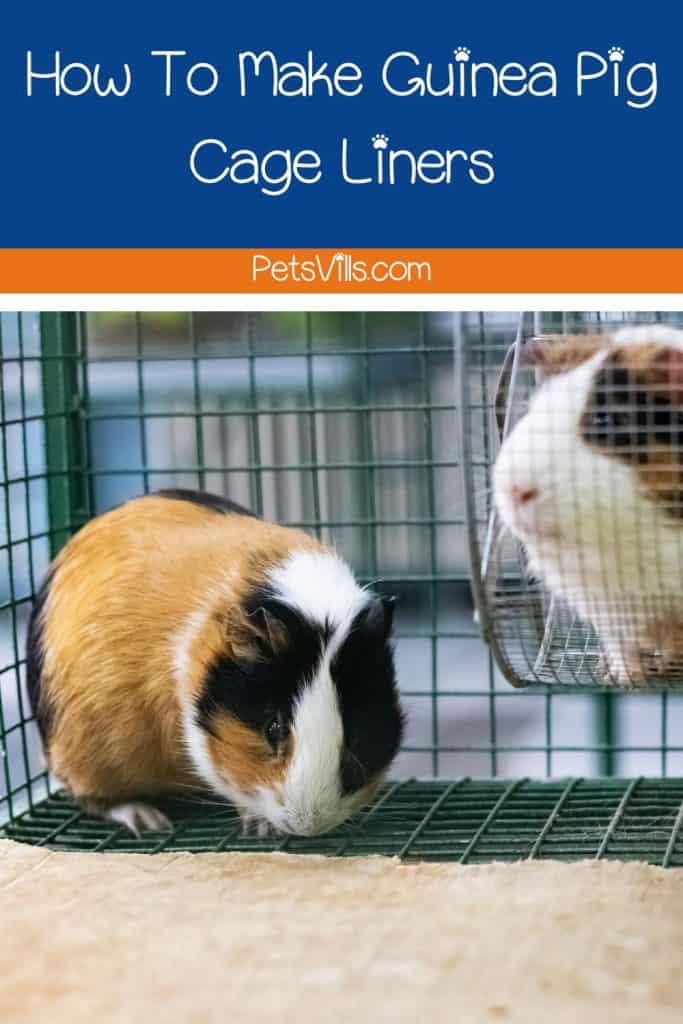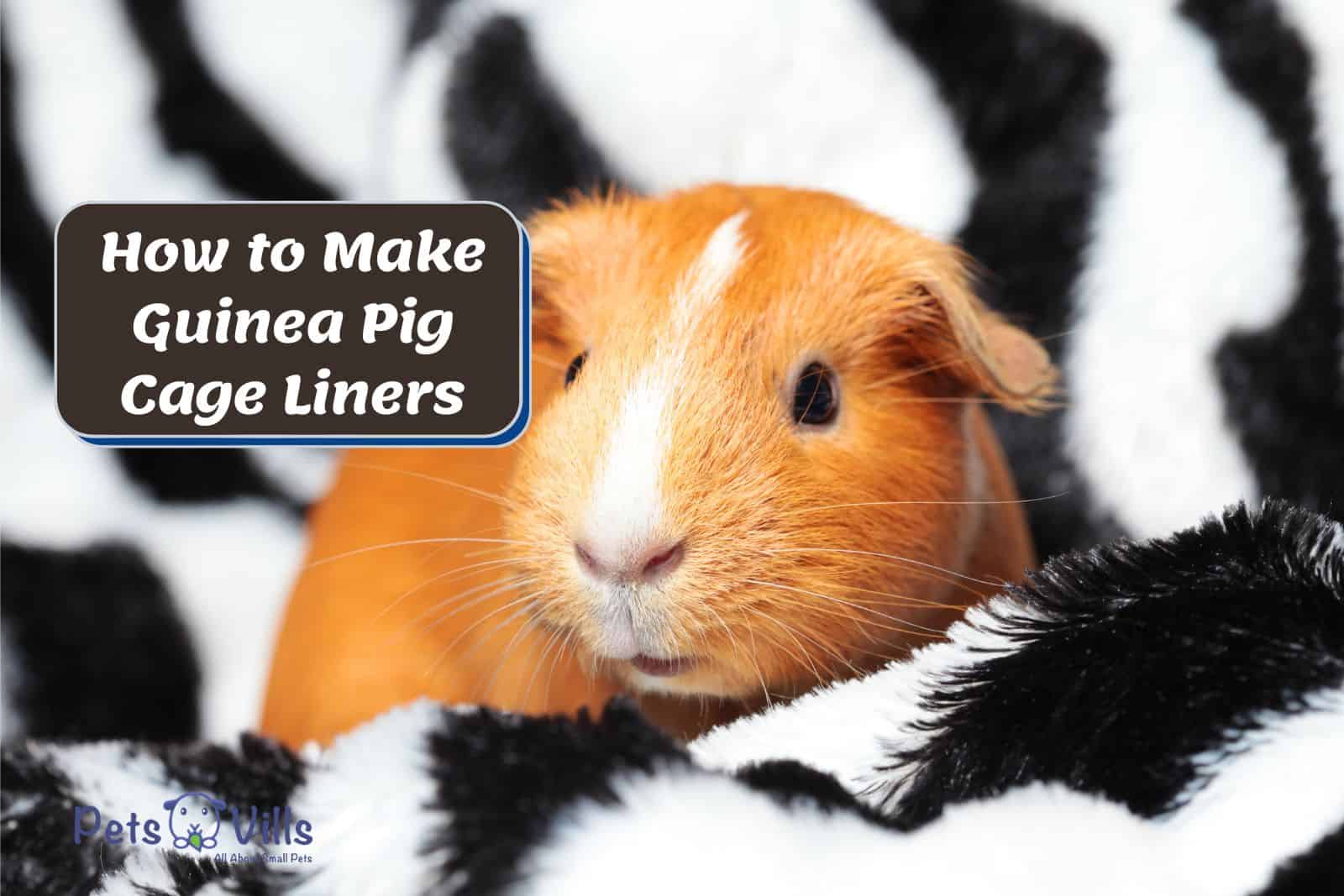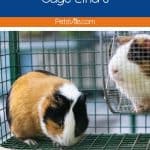Looking for a guide on how to make guinea pig cage liners? Look no further!
As a fellow guinea pig owner, I understand the importance of providing a comfortable and clean environment for your beloved pets.
FYI, this post contains affiliate links. I may earn a small commission if you purchase at no extra cost.
In this post, I’ll discuss the steps to make your own guinea pig cage liners, ensuring your furry friend’s happiness and promoting a greener lifestyle.
Keep reading to learn everything there is to know about creating these fantastic liners today!
Table of Contents
Key Takeaways
- Craft personalized liners with the perfect materials to ensure your guinea pig’s happiness and well-being.
- Tailor the liners to fit your pet’s specific cage size, design preferences, and unique personality.
- Master the essential cleaning and upkeep routine to maintain your furry friend’s fresh, cozy, and hygienic living space.
- Go green and wallet-friendly by creating eco-conscious cage liners that contribute to a sustainable environment.
Curious about making cage liners? Off you go…
How To Make Guinea Pig Cage Liners (6 Easy Steps)
Making a washable guinea pig cage liner can feel intimidating – it’s actually a breeze!
As a guinea owner, I’ve followed these simple steps to create a cozy, functional, and eco-friendly cage liner that both my guinea pig and I adore. You can do it too – here’s how:
1. Measure the cage:
Accurately measure your guinea pig’s cage, adding a half-inch seam allowance on each side for a perfect, burrow-proof fit. This ensures a snug, burrow-proof fit that keeps my little buddy safe and comfortable.
2. Cut the fabric:
Use your measurements to cut two fleece pieces and one absorbent layer, fitting them snugly between the fleece layers.
3. Layer and secure:
Place one fleece piece right-side-up, add the absorbent layer, and top with the second fleece piece right-side-down. Align edges and secure with pins or clips.
4. Sew the layers:
Sew around the edges of the pinned fabric, leaving a half-inch seam allowance. Be sure to leave a small opening on one side to turn the liner right-side-out later.
5. Turn and finish:
Carefully turn the cage liner right-side-out through the opening. Then, tuck in the seam allowance at the opening and sew it closed by hand or with your sewing machine.
6. Quilt the liner (optional):
For added stability and structure, you can add some quilting stitches across the liner. This step is optional but can help keep the absorbent layer in place during washing.
With these simple steps, you’ll create a custom, washable guinea pig cage liner that’s functional and adds a personal touch to your pet’s home.
Better yet, it’s a great way to save money, reduce waste, and provide a cozy environment for your guinea.
Now that you’re a lining ninja let’s discover how to make the best of those tools…
The Crucial Role of Guinea Pig Cage Liners
A safe haven is vital for your guinea pig’s happiness, and cage liners are key in achieving that comfortable space.
In fact, they offer numerous benefits to your adorable pet (and we’ll explore them right now)…
1. Boosts Well-Being
First, cage liners play a vital role in promoting your guinea pig’s overall well-being.
According to Charles S. Farrow, D.V.M., in Veterinary Diagnostic Imaging: Birds, Exotic Pets and Wildlife, osteoarthritis in guinea pigs can often result from previous injuries, such as fractures or sprains, associated with dislocation [6].
Providing a soft, cushioned surface with cage liners can help prevent injuries and reduce the risk of developing osteoarthritis.
2. Temperature Regulation
Also, guinea pigs are sensitive to environmental changes, as noted by Nirah H. Shomer DVM and John E. Harkness DVM in Laboratory Animal Medicine (Third Edition) [4].
Your guineas can easily become heat-stressed, even at temperatures as low as 70°F. This is why cage liners are great…
Cage liners – especially those made with breathable materials like fleece – can help regulate temperature and maintain a comfortable living space for your guinea pig.
3. Eco-Friendly and Sustainable Choice
When you opt for reusable and washable cage liners, you’re making an eco-conscious choice that reduces waste and minimizes the environmental impact.
In fact, this sustainable alternative helps protect our planet for future generations…
4. Supports Vitamin C Intake
The Clinical Veterinary Advisor: Birds and Exotic Pets states that guinea pigs need sufficient vitamin C to maintain their disease resistance and prevent various disorders, including dental disease, swollen joints, and lameness [5].
When you bet on cage liners (like I do), you’ll not only create a more comfortable home for your guinea pig but also contribute to a healthier, happier environment.
I’m content that my guinea is safe, sound, and content – that’s the satisfaction you get when going with cage liners.
Creating DIY Guinea Pig Cage Liners: The Perfect Materials and Tools
What’s the secret to crafting outstanding cage liners? The right tools, of course!
Equipped with the proper tools and materials, you can save money and create a comfortable, hygienic environment for your furry friend.
Plus, you’ll be satisfied knowing you made it yourself, tailored to your guinea pig’s needs. Ready to dig in and learn which tools you need exactly?
Let’s start with the materials:
- Fleece: Choose a soft, wicking fleece fabric that’s easy to clean and provides a comfortable surface. Remember to prep new fleece by washing it several times with unscented detergent and warm water.
- Absorbent cloth: Utilize old towels or purchase absorbent fabric for the middle layer to absorb spills and guinea pig waste.
- Waterproof fabric (optional): Consider using a waterproof fabric like Polyurethane Laminate (PUL) for the bottom layer to keep the cage clean and prevent leakage.
Now for the tools:
- Sewing machine (optional): A sewing machine is helpful but unnecessary. You can sew by hand if preferred.
- Basic sewing supplies: Gather scissors, needles, pins, thread, a marker, and a ruler or measuring tape for your project.
According to a study in Vet World, maintaining a clean and controlled environment is essential for the overall health of guinea pigs [1].
Thanks to these tips, you’ll become a virtuoso DIY line crafter and contribute to this healthy environment, ensuring your guinea is satisfied.
Before you learn about cozy cage liners, watch this video and learn some cool moves:
Creating Cozy Cage Liners for Your Furry Friends
As a proud guinea pig parent, I can’t stress enough the importance of giving our little furry companions the coziest and healthiest environment possible.
Here, I’ll share my expertise and experience in creating the perfect liners for your guinea pigs:
Choose the right material:
Wicking fleece and other absorbent materials work best for guinea pig cage liners.
If you’re looking to purchase the best liner for guinea pig cage, be sure to check out my top recommendations for bedding options that are safe, absorbent, and easy to clean.
Prepare the fabric:
Wash the fleece in hot water and laundry detergent to start wicking. This helps break down the fibers and enhances the fabric’s absorbency.
Create the ideal living space:
Remember, guinea pigs primarily use the periphery of their cage. Thus, providing the right cage liners is crucial for ensuring optimal use of space and maintaining a clean, comfortable living area for your pets.
Cater to their social nature:
Make sure to create an inviting environment that allows them to explore, interact, and stay happy.
Putting in the time and effort to create the perfect cage liners for your guinea pigs is essential to their well-being.
Was I always this crafty expert? Nope! I was clumsy – but I just kept at it, and now I know how to create these cozy liners. You know what else?
Someone said, “Patience is golden,” so take heart, practice, and keep practicing. Only then will you find out that it isn’t that hard!
Cutting Out Your Liner Pieces in 5 Steps
As a devoted guinea parent, I know how important it is to provide a cozy living space for our furry little friends. Here’s a fun and easy guide to making your cage liners!
First, grab those liners and start cutting…
Step 1: Cutting Out Your Liner Pieces
This process is easy once you have all the tools (see my section above.) Once you’ve grabbed all these shiny spanners, get started as follows:
- Measure your guinea pig’s cage (length and width) and add 5 inches to each dimension.
- Mark the measurements on your fleece material.
- Create a rectangle and cut out the first piece.
- Use the first piece as a template to cut the rest.
Remember: you’ll need two fleece pieces and one absorbent layer for each liner.
Step 2: Prepping Your Fleece for Sewing
Now that you’ve cut these pieces, it’s time to prep your fleece – here’s how:
- Lay the first fleece piece with the clearer pattern side facing up.
- Place the second piece on top, with the clear side facing down.
- Position the absorbent layer on top.
- Align the edges and pin them together.
Step 3: Sewing Your Liners: Let’s Get Stitching!
Now stitch till you drop – follow these steps:
- Sew about 1/4″ to 1/5″ from the edge, starting in the middle of a longer side.
- Keep your stitches straight, and avoid pulling the fleece too much.
- Leave a 6-inch hole for turning the liner right side out.
- Turning the Liner Inside Out
- Trim the excess material around the outer edge (leave about 1/4″ for a strong seam).
- Carefully turn the entire liner right side out through the hole.
- Take your time to ensure all corners are poked out, and the liner lies flat.
Step 4: Sewing Up the Hole
- Fold the edges inward and sew a line straight down the opening.
This helps create a comfortable environment, as Brewer et al. (2014) suggested guinea pigs benefit from standard home cages and open-field enriched environments [3].
Step 5: Finishing Your Liners for a Professional Look
Finally, polish those lining for an incredible look as follows:
- Add a final seam around the edge of the liner to hold the layers together.
- Sew about an inch to half an inch from the edge, keeping the liner as flat as possible.
- Add a second seam about 4 inches from the first for extra stability during washing.
- Voilà! Now you have a clean, comfortable, inviting environment for your guinea pigs.
White et al. (1989) observed that “guinea pigs tend to use the periphery of the cage,” so your homemade liners will be a perfect addition to their home. Happy sewing [2]!
FAQs
1. How often should I wash my guinea pig cage liner?
Ideally, wash the cage liner once a week to maintain cleanliness and prevent unpleasant odors. However, if you notice excessive mess or odor, you may need to clean it more frequently.
2. Can I use any type of fleece for guinea pig cage liners?
Rather not. Choose an anti-pill or blizzard fleece, as they wick moisture effectively and are more durable.
Avoid using plush or minky fleece, as they don’t offer sufficient moisture-wicking properties.
3. How can I make my guinea pig cage liner more absorbent?
Add a layer of absorbent material, such as a U-Haul furniture pad, Zorb, or absorbent fabric, between the fleece layers. This extra layer will help keep your guinea pig’s cage clean and comfortable.
4. How do I measure my cage for a custom guinea pig cage liner?
Measure the length and width of your cage’s base, then add a few inches to both dimensions for seam allowances and to ensure a snug fit. Use these measurements to cut your fleece and absorbent layers.
Conclusion
Learning how to make guinea pig cage liners is not only cost-effective but also ensures the comfort and safety of your furry friend.
By following our expert guide, you’ll create a cozy environment for your guinea pig while reducing waste and promoting a sustainable lifestyle.
So go ahead and create those crafty liners – and tell me all about them!
Until next time…

Resources
1. Fitria L, Wijayanti N, Arisuryanti T, Salasia SIO. Health comparison between guinea pigs raised in uncontrolled and controlled environments. Veterinary World. 2022;1575–82.
2. White WJ, Balk MW, Lang CM. Use of cage space by guineapigs. Laboratory Animals. 1989;23:208–14.
3. Brewer JS, Bellinger SA, Joshi P, Kleven GA. Enriched Open Field Facilitates Exercise and Social Interaction in 2 Strains of Guinea Pigs (Cavia porcellus). Journal of the American Association for Laboratory Animal Science : JAALAS [Internet]. 2014;53:344–55. Available from: https://www.ncbi.nlm.nih.gov/pmc/articles/PMC4113233/
4. Shomer NH, Holcombe H, Harkness JE. Chapter 6 – Biology and Diseases of Guinea Pigs [Internet]. Fox JG, Anderson LC, Otto GM, Pritchett-Corning KR, Whary MT, editors. ScienceDirect. Boston: Academic Press; 2015. p. 247–83. Available from: https://www.sciencedirect.com/science/article/pii/B9780124095274000067
5. Mayer J, Donnelly TM, editors. Guinea Pigs [Internet]. ScienceDirect. Saint Louis: W.B. Saunders; 2013 [cited 2023 May 3]. p. 253-285.e1. Available from: https://www.sciencedirect.com/science/article/pii/B9781416039693001396
6. Farrow CS. Chapter 21 – Guinea Pigs [Internet]. Farrow CS, editor. ScienceDirect. Saint Louis: Mosby; 2009 [cited 2023 May 3]. p. 237–58. Available from: https://www.sciencedirect.com/science/article/pii/B9780323025270500223

My name is Ben Roberts, and I absolutely love animals. So, naturally, I love writing about them too! As far as my animals, I have a Pit-bull, a Beagle-lab mix, a Chihuahua, and one old cat. Each one of them provides me with a new adventure every day. And the best part is they’re all best friends. Well, except the cat when he gets a little annoyed.
FIND HIM ON: FACEBOOK and TWITTER.
Read his latest ARTICLES
Learn more about Benhere


